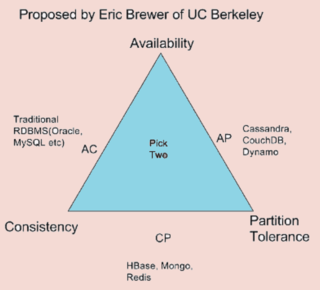System Design-2
 Shivam Saurabh
Shivam SaurabhIn the previous article, I have explained about databases and it’s importance in System Design. Now we will talk about properties of distributed system and CAP theorem (Brewer’s theorem).
Properties of distributed system
There is three main properties of distributed system.
Consistency
Availability
Partition Tolerance
Consistency :- The name explain itself that distributed system should always be consistent. It means all the nodes should have same data at anytime. If any write operation execute then it will update all the nodes then system will show a successful message otherwise it will roll back if any error occur.
Availability :- System should always be available even if there is high load. It means every request should get a response even if one or more than one nodes are down.
Partition Tolerance :- System should continue to work despite message loss or partial failure (partition (communication break) between nodes). It means system should handle any amount of failure that does not result in entire network failure.
CAP Theorem (Brewer’s Theorem) :- It says that any distributed system can not achieve all these three properties. Only 2 of them can be achieved on expense of other.
Therefore, while designing distributed system, choose database carefully according to your requirements.

Databases are classified based on CAP characteristics they support :-
CP databases :- A CP database focus on consistency and partition tolerance. When a partition (communication break) occurs between any two nodes, the system has to shut down the non-consistence node until the partition in resolved.
AP database :- An AP database delivers availability and partition tolerance. when partition occurs, all nodes remains available but those those nodes that is wrong end of partition might return an older version of data than others.
CA databases :- A CA database delivers consistency and availability across all nodes. It can not do this if there is a partition between any two nodes in the system.
Note :- in a distributed system, partitions can’t be avoided. So, while we can discuss a CA distributed database in theory, for all practical purposes a CA distributed database can’t exist. This doesn’t mean you can’t have a CA database for your distributed application if you need one. Many relational databases, such as PostgreSQL, deliver consistency and availability and can be deployed to multiple nodes using replication.
As we are talking about distributed system, therefore splitting up database is an important task. This splitting up the database across multiple machines to improve the scalability is known as Sharding a*nd all the splitted databases is known as **Shards**. sharding is the process of horizontal scaling, which improves manageability, performance, availability and load balancing.*
Sharding techniques:-
Horizontal partitioning
Vertical partitioning
Directory based partitioning
Hash-based partitioning
That’s all for this article. In the next article I will explain each sharding techniques in detail and problem of sharding.
Subscribe to my newsletter
Read articles from Shivam Saurabh directly inside your inbox. Subscribe to the newsletter, and don't miss out.
Written by

Shivam Saurabh
Shivam Saurabh
👋 Hello, fellow tech enthusiasts! I'm a Full Stack Developer with a passion for building scalable and efficient web applications. My journey in the tech world is driven by my curiosity and my desire to turn ideas into reality. My expertise spans across various technologies and languages, enabling me to work on both the front-end and back-end of applications. I believe in writing clean, efficient, and maintainable code that not only solves problems but also creates an engaging user experience. Beyond coding, I have a keen interest in system architecture and design. I enjoy the challenge of designing systems that are robust, scalable, and easy to maintain. I'm always exploring new architectural patterns and design principles to keep my skills sharp and stay ahead of the curve. When I'm not coding or architecting systems, you'll find me diving into tech articles, exploring open-source projects, or contributing to the developer community. I believe in the power of sharing knowledge and learning from others. Feel free to reach out if you want to discuss tech, need some advice, or just want to say hi. Let's connect and create something amazing together! 👩💻🚀